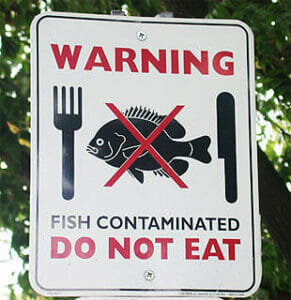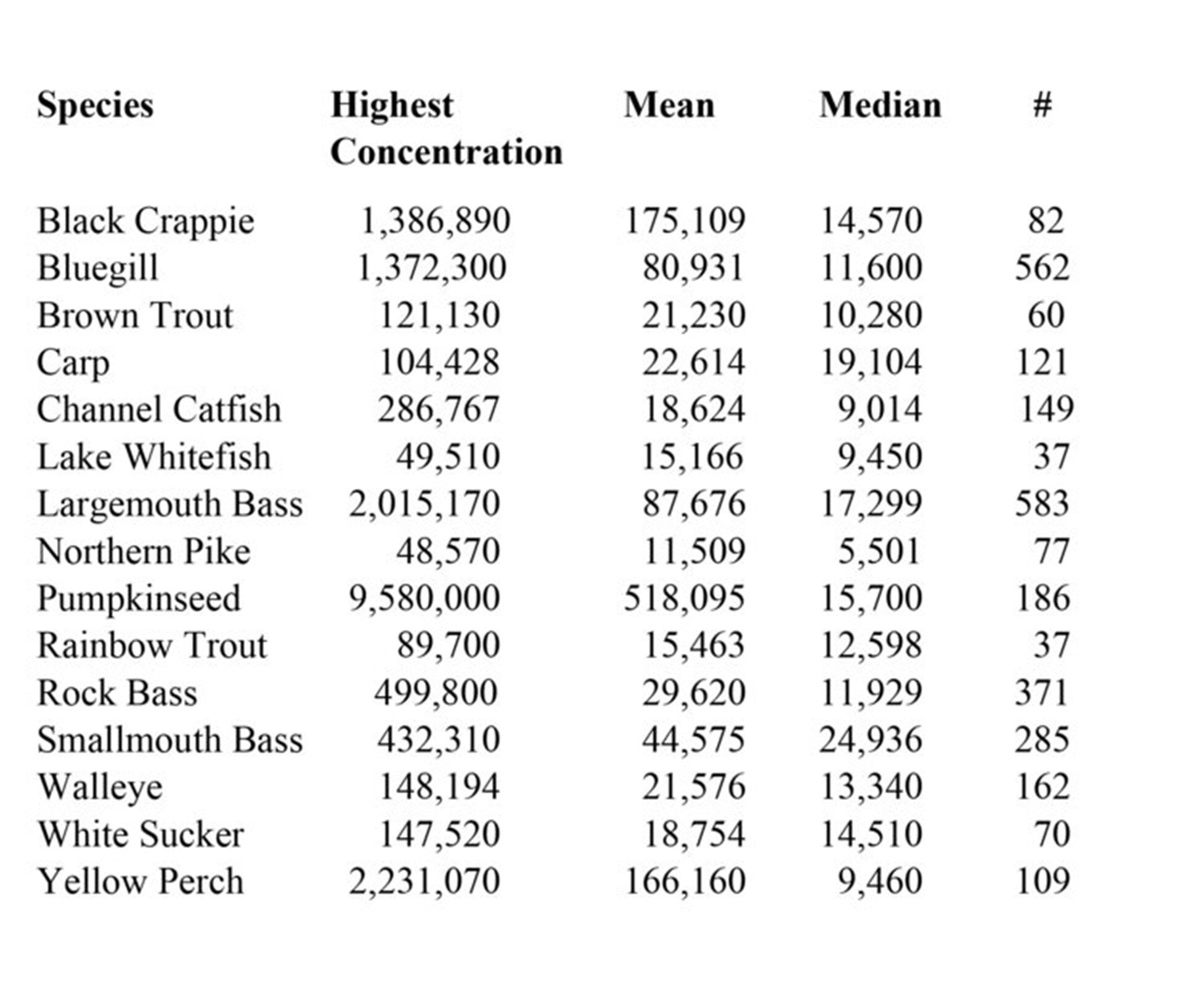The FDA says PFAS in Fish not a Health Concern
By Pat Elder
July 15, 2021
Actually, cancel that. The FDA says the fish are fine.
Despite overwhelming evidence that the nation’s fish are highly contaminated with PFAS, a new U.S. Food and Drug Administration (FDA) report says PFAS levels in fish do not represent a human health concern.
The FDA says it has tested 300 food samples since 2019 and none have contained dangerous levels of PFAS. “Since we began testing foods from the general food supply for PFAS in 2019, only four samples out of the nearly 300 tested have had detectable levels of PFAS, and none have been determined to be at levels of concern for human health,” says acting FDA commissioner Janet Woodcock, MD.
The FDA described a sample of cod that had two types of PFAS – perfluorooctane sulfonate (PFOS) and perfluorononanoic acid (PFNA). The FDA determined that the PFAS levels found in the cod sample do not present a human health concern. “The US food supply is among the safest in the world, and the available scientific evidence does not support avoiding particular foods because of concerns regarding PFAS exposure,” added Woodcock.
The FDA ought to analyze data from the EPA and states like Michigan and Wisconsin on the levels of PFAS in fish. Then, we can have a discussion on whether it’s OK for a woman, in the earliest stages of pregnancy, to consume a six ounce portion of fish containing a million nanograms of the toxic chemicals. Are public health advocates like Harvard’s School of Public Health, the Environmental Working Group and Linda Birnbaum, former Director of the National Institute for Environmental Health Sciences, inflating concerns regarding PFAS?
My daughter is 30 and may become pregnant with our first grandchild. Should she be eating Maryland seafood? I’ve tested fish, crab, and oysters and I know they’re is contaminated. The FDA says the fish are fine. Maryland agencies say the fish, crabs, and oysters are OK to eat. The EPA doesn’t regulate the chemicals. The Navy doesn’t address questions concerning contaminated seafood near its installations.
They all say everything is fine and dandy.
The Biden-Woodcock FDA “advises consumers against avoiding certain foods over PFAS concerns.” You have to read that a second time. The FDA is a cheerleader for the corporate interests that supply our food.
Sadly, America’s fish are severely contaminated with PFAS. An analysis of PFAS concentrations in 3,262 fish and oysters from rivers and lakes in 48 states shows that the country’s seafood is toxic. The average fish in the database contained 93,224 parts per trillion (ppt) of PFAS. The median (middle) value was 13,600 ppt. The data came from the EPA, Michigan, Wisconsin, and a host of other states.
To put these numbers into perspective, the EPA has established a voluntary Lifetime Health Advisory of 70 ppt of PFAS in drinking water while many states have been enforcing much lower levels. Public health officials are increasingly warning that we should not be consuming more than 1 ppt of these substances in our drinking water. But what about the fish?
Generally, fish caught near military bases, wastewater treatment plants, airports, and industrial sites have elevated (and sometimes astronomical) levels of the poisons. People who eat these fish can become extremely ill.
The U.S. Food and Drug Administration is delinquent in its duties to protect American health from the scourges of PFAS. President Biden’s FDA isn’t any better than President Trump’s in this regard. If you click on the database above you can plainly see there are astronomical levels of PFAS in various species of fish all across the country.
The FDA’s rhetoric is frightening. Consider this snippet from the FDA’s website:
Q - Should I stop eating particular foods to reduce my PFAS exposure?
A - There is no scientific evidence that supports avoiding particular foods because of concerns regarding PFAS contamination.
=============
The National Fisheries Institute is an industry trade group that represents the seafood industry. They were pleased with the FDA’s green light on all fish consumption. “What is important to note is that FDA has determined that the traces of PFAS that have been found [in seafood] are not at levels of concern for human health. National Fisheries Institute Director of Communications Melaina Lewis explained.
To put it another way, the fish caught near military installations containing nearly 10 million parts per trillion of PFAS is really only 10 parts per million, which doesn’t sound so bad.
The bottom line from the FDA is that there’s actually too much concern about the health impacts of PFAS in our food. A Navy base or an industrial site may deliver high amounts of PFAS waste to treatment plants that send them into our surface waters or turn them into sludge that are spread on agricultural lands. There’s no one tending to the store, at least not here in Maryland.
This is how the FDA describes agricultural produce grown in PFAS-contaminated soils: “Previous analyses by the FDA have shown that PFAS contamination in the environment where food is grown does not necessarily mean the food itself will contain detectable PFAS. This is because the amount of PFAS taken up by crops depends on many factors, including the specific type of PFAS and characteristics of the food. There is no scientific evidence that supports avoiding particular foods because of concerns regarding PFAS contamination. Foods that are associated with areas of environmental contamination may or may not pose a risk.”
They’re saying the food may pose a risk and they’re not doing anything about it. Ultimately, it’s up to the American people to regulate the PFAS entering their bodies.
The FDA says “when levels of PFAS in foods are determined to be a human health concern, they work closely with state and local officials, as well as our federal partners, to assess each situation and take appropriate steps to ensure the food does not enter the market. “ If this is the case, then the results of food tests conducted by the FDA in 2019 aren’t considered by the FDA to be a human health concern:
PFAS in Food
Bread from Cleveland Sav-a-lot 14,700 ppt
Apples in Decatur, AL Krogers 2,350
Apples in Pensacola ---- 1,130
Ground Beef Port St. Lucie, FL Albertson’s 1,090
Milk in Pensacola Food World II 852
Milk in Columbus, GA Winn-Dixie 693
Ground Beef in Mobile, AL Delchamps 587
Milk in Cleveland Sav-a-lot 573
Green Beans in Mobile. AL Delchamps 543
Bread in Pensacola Food World II 524
Ground Beef in Port St. Lucie Publix 504
A fried fish sandwich loaded with PFAS on bread from Sav-a-lot is fitting in a town like Cleveland where the rain contains 1,000 parts per trillion of PFAS.
Nobody gives a damn, at least not here.
The European Food Safety Authority says that 86% of the PFAS in adults comes from the food we eat, especially fish taken from contaminated waters. They’ve set a Tolerable Weekly Intake (TWI) at 4.4 nanograms per kilogram of body weight. So, according to this guideline, a child weighing 50 pounds can “safely” consume 100 nanograms per week of PFAS chemicals.
The average 6-ounce serving of fish (93,224 ppt) in our database of 3,262 fish and oysters is 158 times over the EFSA weekly limit for the child. Our little guy may consume up to .41 ounce per week of the average American fish, about the size of the child’s thumb. https://www.militarypoisons.org/latest-news/americas-fish-are-contaminated-with-pfas
A 6-ounce portion of the Pumpkinseed fish at the top of our chart, caught near the old burn pit at Wurtsmuth AFB, contains 1,653,899 nanograms of PFAS. Using responsible European standards, a 50-pound child may “safely” consume a little less than .01 gram of this fish weekly. That’s roughly the size of a pea.
The data below is taken from our study of PFAS concentrations in 3,262 fish and oysters from rivers and lakes in 48 states. Values are in parts per trillion.
Every 10,000 ppt represents a 6-ounce serving of fish that is 17 times over the
European weekly limit, while the FDA says there’s no problem.
Thank you,
Pat Elder pelder@militarypoisons.org


